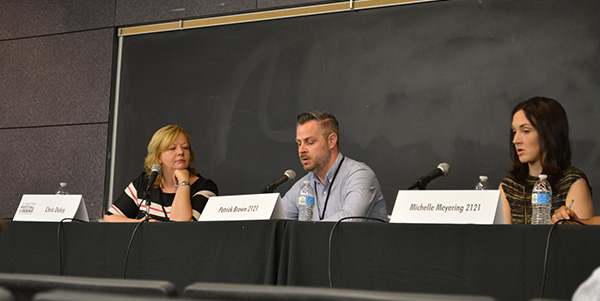
2014 LA Times Festival of Books: Reaching Readers, Reaching Writers
Note: this article was also published on Neon Tommy.
Being a reader today is more varied than ever before. With more options for your leisure time (and money), combined with the concept of the filter bubble where you only hear what you want to hear, finding something to read (or, if you’re a writer, finding an audience) is not the easiest task in the world.
The “Reaching Readers, Reaching Writers” panel at the LA Times Festival of Books featured Patrick Brown, director of author marketing at Goodreads; Michelle Meyering, founding editor of the literary magazine The Rattling Wall; and David Kipen, founder of Libros Schmibros. They talked about that elusive task of finding readers as well as new writers.
The main goal when obtaining new readers is the notion of community. Moderator Chris Daley started the conversation with the idea that all three panelists shared similarities in making the act of reading be a shared experience.
“Reading can be a very communal activity,” Kipen said. “The whole assumption that reading is a solitary activity is a total canard. Readers lead the most social lives in between the reading experience of anybody. They vote more, they go out to the theater more, they go to concerts more, they go to sporting events more. I don’t know what it is about the chemistry of ink on pulp, but somehow it gives you these extra six, eight, 12 hours a day in which to do other stuff, too. So we’re sociable folk when we’re not being anti-social.”
While each of the panelists were in a way gatekeepers to what people want to read, Brown discussed the idea that he considers himself more of a curator rather than a gatekeeper. He brought up the idea behind Goodreads, how it’s not necessarily one big giant book club, but rather a bunch of little book clubs all sharing the same virtual space.

One example is the people who read young adult literature. “The online community [in the young adult genre] is incredibly passionate,” said Brown. “Bringing together the readers into something more than just a readership, into like a passionate following, is something that YA authors for whatever reason have been able to figure out and harness.” He went on to discuss how the literary world still hasn’t broken into that online community aspect.
Kipen also shunned the idea of being a gatekeeper, likening himself to more of a bouncer or the “checkout guy at the liquor store. I card people. Younger readers: anything is fair game. If they’re reading, that’s the start. That’s the seed. But if you are over 18, if you’re older than me, it’s time you’re reading good books.”
The conversation naturally turned from being a reader to being a writer and finding an audience. Those extended options for your leisure time also means there’s more people writing, and self-publishing no longer has the stigma it once did.
“The first thing you have to decide is how are you going to bring it to market?” Brown asked, when discussing finding an audience for a story. “There are so many different options now for authors. It’s an empowering time in the sense of you can actually just reach readers directly with a book. I’m not going to pretend that that’s easy, and ultimately you still have to have a goal between the pages.”
The one piece of advice all three gave to aspiring writers, though, is to run it by a good editor who you trust to be honest but also be true to your story.
See my other article covering the 2014 LA Festival of Books, and see all my photos from that day on my Flickr.















